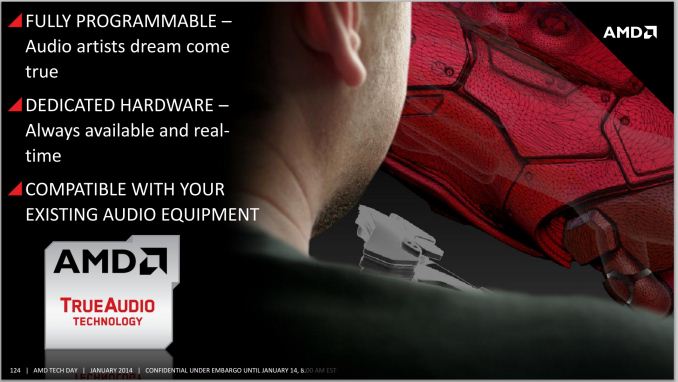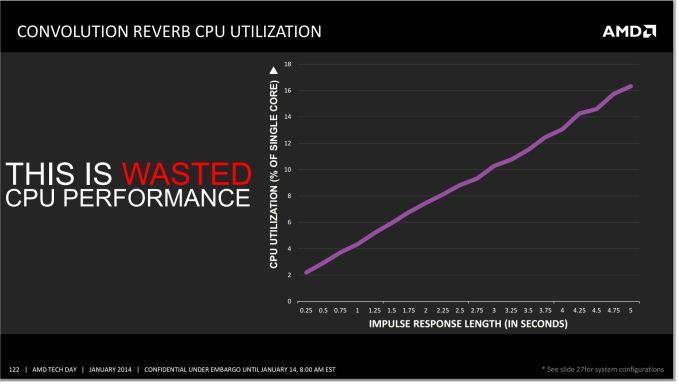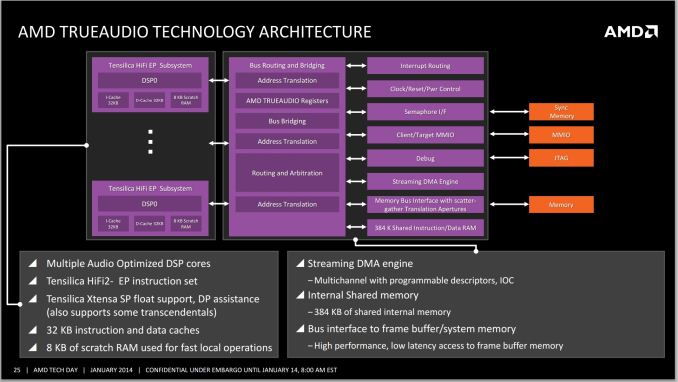AMD Kaveri Review: A8-7600 and A10-7850K Tested
by Ian Cutress & Rahul Garg on January 14, 2014 8:00 AM ESTTrueAudio
As part of the Kaveri package, AMD is also focusing on adding and updating their fixed function units / accelerators. Due to the jump on the GPU side to GCN we now have the TrueAudio DSP to allow developers to increase the audio capabilities in game, and both the Video Codec Engine (VCE) and Unified Video Decoder (UVD) have been updated.
All the major GPU manufacturers on the desktop side (AMD, NVIDIA, Intel) are pushing new technologies to help improve the experience of owning one of their products. There are clearly many ways to approach this – gaming, compute, content consumption, low power, high performance and so on. This is why we have seen feature like FreeSync, G-Sync, QuickSync, OpenCL adoption and the like become part of the fold in terms of these graphics solutions.
AMD’s new feature is TrueAudio - a fully programmable dedicated hardware element to offload audio tasks to.
The main problem with developing new tools comes down to whether they should be implemented in a general fashion or with a dedicated element. This comes down to the distinction of having a CPU or an ASIC do the work – if the type of work is specific and never changes, then an ASIC makes sense due to its small size, low power overhead and high throughput. A CPU wins out when the work is not clearly defined and it might change, so it opens up the realm of flexibility in exchange for performance per watt.
CPUs are now significantly powerful that a range of audio based techniques are available to them and the algorithms are optimized. The only limitation in this regard is the imagination of the developer or audio artist, which actually becomes part of the problem. When implementing an audio filter on the fly to a video game, the processing via the CPU can be overly taxing, especially when the effect is persistent over a long time. The example AMD gave in their press slide deck is one of adding reverb to an audio sample. The longer the reverb, the bigger the draw on CPU resources:
AMD cites this CPU usage as the effect of one filter on one audio sample. Imagine being in a firefight situation in a video game, whereby there are many people running around with multiple gunshots, splatter audio and explosions occurring. Implementing effects on all, and then transposing audio location to the position of the character is actually computationally expensive, all for the sake of realism. This is where the TrueAudio unit comes into play – the purpose is to offload all of this onto a dedicated bit of silicon that has the pathways built in for quicker calculations.
TrueAudio is also implemented on AMD's latest-generation R9 260 and R9 290 video cards – basically anything at least GCN 1.1 and up. Meanwhile we also know that the PS4’s audio DSP is based on TrueAudio, though given the insular nature of console development it's not clear whether the APIs are also the same on both platforms. AMD for their part is working with major audio middleware plugins (wwise, Bink) in order to help develop the TrueAudio ecosystem, so even in the case where the APIs are dissimilar, middleware developers can abstract that and focus on the similarities in the hardware underneath.
As is usually the case for these additional hardware features, games will need to specifically be coded to use TrueAudio, and as such the benefits of TrueAudio will be game specific. At the same time there are not any games currently on the market that can take advantage of the feature, so the hardware is arriving before there is software ready to use it. The first three games on AMD's list that will support TrueAudio are Murdered: Soul Suspect, Thief, and Lichdom. Much like FreeSync, I expect the proof is in the pudding and we will have to wait to see how it can affect the immersion factor of these titles.
Unified Video Decoder and Video Codec Engine
I wanted to include some talk about the UVD and VCE with Kaveri as both are updated – we get UVD 4, an update to error resiliency for H.264, and VCE 2, as shown below:
Of the two blocks, the improved VCE has the more interesting improvements to discuss. With the addition of support for B frames in H.264 encoding, the resulting ability to do backwards frame prediction should help improve the resulting image quality from VCE and/or reduce the required bitrates for any given quality level. Meanwhile the addition of support for the higher quality YUV444 color space in the H.264 encoder should help with the compression of primarily linear lineart/text, which in turn is important for the clarity of wireless displays.





















380 Comments
View All Comments
HanzNFranzen - Saturday, January 18, 2014 - link
Yea, 90% of people use Battlefield 4 90% of their time on the PC... You missed the question.keveazy - Saturday, January 18, 2014 - link
Doesn't matter.If you buy a PC, it's better to make sure it's solid and ready to handle applications that require strong physical cpu performance unless your still living the 90s dude.
My point is, AMD's highest end kaveri 7850k chip today is priced at the same range as Intel's low end i5 cpus. From here, you take your pic. If you wanna have a system that has worse graphics than ps4, go AMD.
kmi187 - Sunday, January 19, 2014 - link
If you've actually lived in the 90's you would know that cpu power was a lot more important back then than it is now. You didn't have hardware (gpu) acceleration for video and all that jazz to put less stress on the cpu.Also you do realize the PS4 runs on AMD hardware right?
medi02 - Tuesday, January 28, 2014 - link
What on earth are you talking about? What is a "solid PC"? One that fails at games?cryptik - Monday, March 30, 2015 - link
Today (30 Mar 2015) the AMD A8-7600 is the same price ($99) as the Intel Pentium G3460. The "lowest end" i5 CPU is $189. You're simply a liar who has no idea what he's talking about.vAngz - Sunday, January 26, 2014 - link
I believe you and others are missing the point. Can you play Battlefield 4 on medium settings @ 1080p using only the i5 4430, without using a discrete graphics card, and it still be playable above 30fps?Even though the chips are the same price (at most places), you can actually play BF4 using only the A10 7850K, which is not possible with the i5 4430. I bring this up mainly because you brought up BF4. When, rather if, Mantle is ever activated on BF4, things will change and we will see even better performance on the A10-7850K and later gen AMD APUs.
So, yes, you can get better performance out of the i5 4430, but you will need to spend more money on a discrete graphics card to use it for gaming, such as for BF4. I believe this what sets the AMD APUs apart from Intel offerings at the moment. We need to compare apples to apples.
I could be wrong, but I haven't seen anywhere in my research where anyone is getting that kind of performance out of i5 4430 without a discrete graphics card added into the mix. If you have a link on such info please share it with us. Thanks.
keveazy - Friday, February 7, 2014 - link
Your not getting it either. My mistake in my previous post is I didn't mention Battlefield 4 Multiplayer.That's where the APU will fail. It will fail in both the Cpu performance and Gpu performance. The APU is still the better choice at light gaming.
theduckofdeath - Wednesday, January 15, 2014 - link
I think he's referencing that processor simply because it's a pretty powerful, fairly low-priced processor for all of those who can live without all of those over-clocker tweaks...just4U - Tuesday, January 14, 2014 - link
You talk about 2500K performance and yet the majority of people I come across are not even working with that. The vast majority are still in the C2D/8800 like performance arena. What would be nice to see from some of these review sites in their performance analysis is if stuff like this makes sense to finally bite the bullet and get rid of the old dog..just4U - Tuesday, January 14, 2014 - link
Ian .. that's something I think you should look at btw.. we do get a fair number of lurkers /w some posting up questions like that about how it compares to the old warhorses their on. Hell even for those of us with old parts kicking around it's something to consider. Do we scrounge up some cheap ddr2 psu.. hand me down hard drives and pair it up for that box in front of the television or do we say no.. this makes far more sense and it's new.